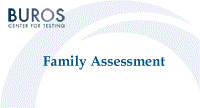Buros-Nebraska Series on Measurement and Testing

Family Assessment
Date of this Version
1995
Document Type
Article
Citation
Family Assessment, ed. Jane Close Conoley & Elaine Buterick Werth (Lincoln, NE: Buros Institute of Mental Measurements, University of Nebraska-Lincoln, 1995).
Abstract
INTRODUCTION
The nature of sibling relationships has been given considerable empirical attention. Research has focused on describing the nature of sibling interaction and roles siblings play in each others' lives, as well as on attempting to support the contention that the sibling relationship can impact children's psychosocial development (Dunn, 1983). The latter purpose has been influenced by two areas: behavior genetics and family systems theory.
Behavior geneticists have proposed that although siblings have roughly half their segregating genes in common, environmental influences operate in a way that makes siblings no more alike than two children chosen at random from the population (Plomin, 1986). Specifically, most environmental influences that affect children appear to be nonshared among family members. Children's psychosocial development, therefore, is influenced mainly by their genetic composition and environmental variables such as peer interactions, sibling treatment of each other, and possibly parental treatment that is those unique to individuals in the same family (Plomin & Daniels, 1987). Rowe and Plomin (1981) stated that interactions between siblings leads to differences between them because they treat each other differently (i.e., due to their natural style of behavior), and because they can play complementary roles that reinforce the differences between them. Therefore, siblings influence the behavior and development of each other by providing different environments for each other.
Systems theory has also impacted sibling research. Carlson in Chapter 2 of this volume discusses the major tenets of systems theory, and they will not be repeated here. According to family systems theory, siblings constitute a major subsystem of the larger family system (Minuchin, 1985), and as such impact the behavior and development of children. The influence of siblings can be direct (e.g., through sibling-sibling interaction) or indirect (e.g., one sibling's presence can affect parental behavior toward another sibling). All members of a family are interrelated and mutually influential parts of the family unit, and therefore no individual (or set of individuals) should be studied in isolation without considering the influence of other parties.
This chapter is premised on the view that sibling relationships are in fact an important part of children's psychosocial development. The first sections of the chapter review research related to sibling relationships. Various aspects and characteristics of such relationships are discussed, and factors related to relationship quality are reviewed. Given that siblings play a prominent role in children's lives, it is proposed that sibling relationships are of significance to both researchers and clinicians working with and studying children and families. The second section of the chapter therefore addresses strategies for assessing sibling interaction and related measurement issues.
Included in
Educational Assessment, Evaluation, and Research Commons, Family, Life Course, and Society Commons, Quantitative, Qualitative, Comparative, and Historical Methodologies Commons


Comments
Copyright © 1995 by Buros Institute of Mental Measurements. Digital Edition copyright © 2012 Buros Center for Testing.